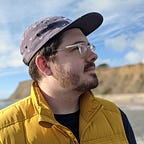Humane Virtuality Internship
Creating my own experience in lieu of a professional internship, researching the future of user experience design in virtual reality
Over the next three months, I will create a series of interactive virtual/augmented/mixed reality prototypes in an effort to explore the new challenges facing user experience design. As spatial interfaces become more prevalent, it is important that designers understand the benefits and drawbacks, especially with relation to human perception (e.g. nausea).
tl;dr. I have four goals: learn; design humanely; create rapid, interactive prototypes; and regularly share my work. I face a series of constraints: money, time, and lack of a team. This is a self-guided effort started by me not getting an internship.
My plan is multifaceted. I’ll create prototypes to test interaction ideas. Then, I’ll test these prototypes on people with a focus on less technically-savvy users. These prototypes will come in three layers of complexity.
- Interaction Prototypes: simple explorations of a granular concept
- App Prototypes: a rudimentary exploration of an existing type of application, ported to virtual reality
- Robust App: a polished experience
Each time I create something, I’ll do a short write up about my design decisions, a bit about the technical work, and findings from user testing.
Why this?
I’m a master’s student at Carnegie Mellon University in the Human-Computer Interaction Institute. The specific program I’m in has a partnership with the Madeira Interactive Technologies Institute. (Those all abbreviate to CMU, HCII, and M-ITI.) Anyway, the program is situated as such:
We spend a semester at CMU, then two semesters in Portugal, separated by a one semester internship. My cohorts and I started searching for internships right when we got to the island (yes, M-ITI lives on an sub-tropical island).
When I was searching, I looked for UX design internships at VR companies and internships at R&D labs. Well, it turns out that most VR companies are looking for full-time designers, not interns. I applied anyway, but to no avail. As the summer neared, I could either start applying for general UX design positions (for web and mobile apps) or I could forge my own path. Skimming my finances and available credit, I decided that to get what I need out of an internship, it would be better for me to create my own. So that’s what this is.
I have four goals.
First, I will learn more software to help me express my ideas. This will primarily include JavaScript and Unity. Code in particular allows for a higher degree of flexibility than designed tools (though it is not without downsides). At this stage in the game, there are not better tools to work with for VR.
Second, I will focus on creating humane designs. I mean, this is really my role as a UX designer anyway, but it’s important to put some emphasis here. As we move into what is potentially the new dominant medium (spatial interfaces), and as we do this in the design-focused movement of the last few years, we should force great human design into our new applications (inspired by Bret Victor).
Third, I will design through rapid interactive prototypes. While apps and websites can easily be expressed on paper, spatial interfaces require prototypes that match its dimensionality. Additionally, I need to get better at producing many prototypes to explore an idea (inspired by Linda Dong).
Fourth, I will regularly share and interact with my greater communities. Experimentation done in a vacuum is largely worthless. I’ve spent the last few months absorbing a great deal of knowledge from others working in the VR space. Because of their work, I start mine on more solid footing. Hopefully because of my efforts, others can start their work more easily. And, sharing regularly gives me a chance to refine my documentation skills.
I face constraints: money, time, team.
A designer’s job is to work inside of constraints while simultaneously questioning the constraint’s reality. It is important to call notice to constraints at the beginning of a project to more accurately set our expectations. In this project, my constraints are specifically money, time, and team.
Damn it.
— Me when I saw the price points for the high-fidelity VR systems
I’ve wanted to buy an Oculus or a Vive since the Oculus’ dev kit launch and the Vive’s first mention. I’m also a master’s student who has had to make a few major moves recently, who has a cat with expenses, and who has a partner he temporarily assisted. All in all it is prohibitive for me to buy a multi-hundred dollar headset plus the thousand(+) dollar computer to run the system. While I can be a gambling man, if I bought the system I want, I’d be beyond payable debt to Capital One.
So, instead of working on a fancy-pants system, I’ll push the limits with a Google Cardboard. This has an upside: it is likely that the majority of people will use a mobile headset before they use a higher fidelity one. I’m working on a more democratic system.
In addition to my available finances, I have only a few months to get through the work I want to accomplish. I am a team of one, so I can’t rely on others to help me through parts-unknown.
My Experience Thus Far
I’ve designed a handful of VR projects including (1) a research project that tested whether haptic feedback changes moral decisions, (2) a prototype for an installation art piece about media bias, and (3) an experience that uses data from Craigslist’s Missed Connection posts. In addition to my work, I religiously read VR news.
That’s the plan. Onward and upward. See you later this week.
Subscribe to the collection to keep updated.
